Mexican Independence to the Texas Revolution
1821 - Colonization and Mexican Independence from Spain
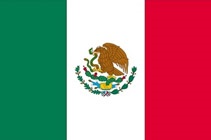 Moses Austin is commissioned as an empresario by the Spanish government. He is authorized to bring immigrants from the U.S. and Europe to Tejas (Texas) to bolster the Spanish possession of the vast area.
Moses Austin is commissioned as an empresario by the Spanish government. He is authorized to bring immigrants from the U.S. and Europe to Tejas (Texas) to bolster the Spanish possession of the vast area.
Settlers are offered land in Tejas if they will become naturalized Mexican citizens, adopt the Catholic faith and learn Spanish. After the untimely death of Moses Austin, his son Stephen F. Austin assumes the commission.
Mexico declares its independence from Spain in 1821. By 1823, Mexico, concerned over the potential annexation of sparsely populated Tejas by the United States, renews and expands its settlement system. Between 1821 and 1830 Mexico permitted more settlement colonies as American and European immigrants stream into the Mexican state of Tejas y Coahuila.
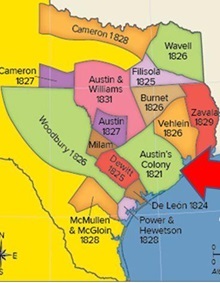 Violent conflict soon follows. Settlers learn that Tejas is fertile land, but complex and hotly contested. Land given over to Austin and others for settlement colonies is already occupied, home to indigenous tribes such as the Tonkawa, Karankawa, Waco, and Apache. Displaced tribes, such as the Cherokee, were also relocating to Texas after being forced out of lands in the east and Midwest.
Violent conflict soon follows. Settlers learn that Tejas is fertile land, but complex and hotly contested. Land given over to Austin and others for settlement colonies is already occupied, home to indigenous tribes such as the Tonkawa, Karankawa, Waco, and Apache. Displaced tribes, such as the Cherokee, were also relocating to Texas after being forced out of lands in the east and Midwest.
Furthermore, nomadic tribes, such as the Comanche, who had arrived in the early 1700s, had raided indigenous villages generations.
By 1823 isolated and poorly defended farms, ranches and settlements become targets for retaliatory attacks by displaced indigenous peoples and raids by nomadic marauders.
1823 - Evolution of the Texas Rangers
The newly established government of Mexico is wracked by political and economic turmoil following Independence. It cannot protect isolated farms and ranches in distant Texas from Indian raids.
In response to requests, the Mexican government moves a company of 10 regular soldiers to Austin's Colony from the Presidio of San Antonio de Béxar. They prove unable to protect the vast area. Militias are created from administrative districts across Austin's Colony, but they are poorly trained, ill-equipped and often on foot.
On January 7, 1823, John Jackson Tumlinson, alcalde (administrator) of the Colorado District of Austin’s Colony, and Robert Kuykendall, a militia commander, write to the governor of Coahuila y Tejas, José Félix Trespalacios. They request permission to raise a mobile company of 15 men, under authority granted to Stephen Austin, that will supplement the soldiers from San Antonio and militias.
Between May 5 and July 5, 1823, a company of men, recruited by Governor Trespalacios and Moses Morrison, a lieutenant of militia, takes to the field. The men are not soldiers, but farmers, ranchers and tradesmen. Some were on foot and they are poorly trained and equipped. The surviving muster roll of Morrison's company of volunteers is arguably the first list of Texas Rangers.
Morrison's company is tasked with building blockhouses as guard posts and constructing boats for raids against encampments of Indian raiders along the coast and tributaries, The campaign is largely ineffective.
By August of 1823 Austin realizes that a larger, mobile force is needed. He issues a famous call for an additional 10 men "to supplement Lt. Morrison’s company and “range for the common defense.”
"I have determined to augment at my own private expense the company of men which was raised by the late Governor Trespalacios for the defense of the Colony against hostile Indians... I will employ ten men in addition to those employed by the government to act as rangers for the common defense.
The said ten men will form a part of Lieut. Moses Morrisons Company and the whole will be subject to my orders. The wages I will give said ten men is fifteen dollars a month payable in property...." Stephen F. Austin, 1823
Austin personally commands the “ranging men” commanding them in English and Spanish. He creates a mobile horseback patrol, borrowing freely from Indian fieldcraft, proven Spanish military and vaquero (cowboy) knowhow, and incorporating Anglo-European minutemen structure and firearms technology. Later authors will say that a Texian ranging man could "ride like a Mexican, trail like an Indian, shoot like a Tennessean, and fight like the devil."
These first "rangers" are diverse in heritage including Tejanos (Hispanos), Native Americans and settlers from US states and territories and Europe. Captains and commanders include Lipan Apaches, Tejanos, Germans, British, Scandinavians, Tennesseans and others. They are united by the concept of mutual protection on a dangerous frontier.
1824
Mexico enacts a Constitution, based on the U.S. Constitution, establishing a republican government. However, it fails to define the rights of states within the Republic, which will become one of numerous issues and motivations leading to the Texas Revolution.
1824-25
Ranger companies engage in skirmishes with bands of Comanche, Karankawa, Waco, Tehuacani and Tonkawa Indians. Distinguishing between tribal groups is difficult due to the lack of central authority among the various bands of Indians and changing allegiances.
1829
Mexico refuses an American offer to buy Tejas for $5 million.
1830
Mexico imposes strict limits on immigration to Texas from the United States. The Central Government fears that runaway immigration will result in Tejas becoming a de facto U.S. Territory.
The Mexican government also orders settlers to comply with an 1829 order emancipating all slaves.
Immigration restrictions are later relaxed, but immigration restrictions and the order abolishing slavery creates a divide between the naturalized Texas settlers and the Mexican Central Government.
Between 1823 and 1836 an estimated 50,000 settlers will arrive in Texas from the United States and Europe.
1832-33
June 26, 1832 - The Battle of Velasco is the first conflict between Mexican soldiers and Texas settlers. Mexican commander Domingo de Ugartechea surrenders after running out of ammunition.
Settlers propose recognition of Texas as a Mexican state. The Mexican Central Government rejects their request and Texas remains part of the state of Tejas y Coahuila.
Settlers hold the first of two conventions to protest Mexican Central Government treatment.
1833
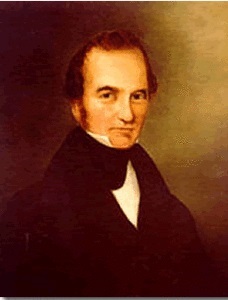 Stephen F. Austin journeys to Mexico City to petition for states' rights and equitable treatment of settlers. The Vice-president, Gomez Farias, refuses to meet with him because President Santa Anna is never available. After many bureaucratic delays, Austin gives up and leaves for Texas.
Stephen F. Austin journeys to Mexico City to petition for states' rights and equitable treatment of settlers. The Vice-president, Gomez Farias, refuses to meet with him because President Santa Anna is never available. After many bureaucratic delays, Austin gives up and leaves for Texas.
On the long return trip, Austin is overtaken by Mexican troops and arrested for inciting revolution. He will be imprisoned without due process until September of 1835. After having pleaded with the Tejas settlers for moderation, he now becomes a fervent believer in the Texas Independence movement.
Samuel Colt patents his design for a revolving pistol, designed as a gentleman's pocket pistol. Although the Texas Rangers will use it with great success in the 1840s, initial sales are lackluster and Colt eventually goes bankrupt.
1834
 In a political and military coup, Antonio López de Santa Anna Pérez de Lebrón deposes his Vice-president and declares himself Dictator of Mexico, and suspends the democratic Mexican Constitution of 1824 He would later return to office as President of Mexico five times.
In a political and military coup, Antonio López de Santa Anna Pérez de Lebrón deposes his Vice-president and declares himself Dictator of Mexico, and suspends the democratic Mexican Constitution of 1824 He would later return to office as President of Mexico five times.
Settlers in Tejas view the situation with concern and resentment. Their growing list of grievances include living under a dictatorship; the suspension of the democratic Constitution of 1824; the denial of state-level autonomy for Texas; the order to emancipate slaves; and the imprisonment of Stephen F. Austin Austin..
1835
September - In a conciliatory gesture, Santa Anna releases Stephen F. Austin from prison.
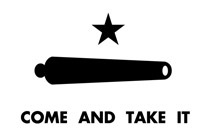 October 2 - A division of Mexican cavalry is sent to Gonzales to confiscate a cannon originally given to the local settlers for defense against raiding Indians. 51 settlers repulse the Mexican force under a banner bearing the words "Come and Take It." This marks the beginning of the Texas Revolution.
October 2 - A division of Mexican cavalry is sent to Gonzales to confiscate a cannon originally given to the local settlers for defense against raiding Indians. 51 settlers repulse the Mexican force under a banner bearing the words "Come and Take It." This marks the beginning of the Texas Revolution.
October 9 - Volunteers under George Collingsworth and Ben Milam capture the Mexican presidio (fort) of Goliad, near San Antonio and its supply depot. Volunteers under the command of Stephen F. Austin, camp near San Antonio and begin the Siege of San Antonio de Bexar.
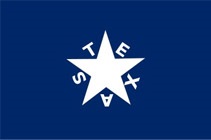 November 3 - A provisional Texas government is established by the "Consultation of 1835." The Consultation authorizes recruiting of 25 Rangers, this is later increased to three companies of 56 men each.
November 3 - A provisional Texas government is established by the "Consultation of 1835." The Consultation authorizes recruiting of 25 Rangers, this is later increased to three companies of 56 men each.
In the coming fighting, loose organization makes it difficult to determine who fights as a member of the "Texian Army" and who serves as a Ranger. Ranger and Army units often fight together with the same command structure.
December 9 - Mexican General Martín Perfecto de Cos surrenders San Antonio to the Texian Army.
1836 - Battle of the Alamo
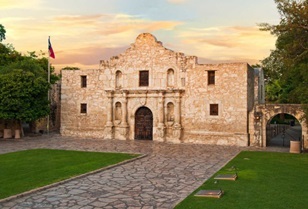 January - Santa Anna leads the Mexican Army, arguably the best trained and equipped military force in the world, north to put down the rebellion.
January - Santa Anna leads the Mexican Army, arguably the best trained and equipped military force in the world, north to put down the rebellion.
February - Col. William B. Travis is sent to San Antonio, just ahead of a large force of Mexican troops, to remove artillery, destroy or remove supplies and perhaps raze the Alamo. His orders are to deny the former mission, and anything of value in it, to the Mexican Army. Finding little of value after the siege of San Antonio, Travis elects to ignore his orders and defend the crumbling walls of the Alamo to buy time for the withdrawal of civilians and the organization of Texas troops.
James Fanin and his troops ignore orders from President Sam Houston to withdraw from the Presidio of Goliad. Like Travis' forces at the Alamo, they elect to stay and defend the post.
March 1- The Gonzales Ranging Company of Mounted Volunteers is the only group to answer Col. Travis' call for assistance in defending the Alamo. This party of Texas Rangers dies alongside the other defenders of the Alamo.
March - A Texas Ranger detachment rescues a child of Sarah Hibbons kidnapped by Comanches.
March 2 - The Texas Declaration of Independence is signed and the Republic of Texas born.
March 6 - After a two-week siege, a Mexican force estimated at 5,000 overwhelms the estimated 190 defenders of the Alamo. All of the defenders perish -- including the Gonzales ranging company and seven Hispanic defenders opposing Santa Anna's coup.
March 19 - After receiving news of the fall of the Alamo, some 300 Texians at Goliad under Fannin, including Rangers, soldiers and noncombatants, begin a retreat. Unfortunately, it is too late -- Santa Anna catches them on the open prairie and accepts their surrender after a small skirmish.
March 27 - On Palm Sunday, Fannin's entire command is marched into the fields near Goliad and executed at Gen. Santa Anna's order. An estimated 350 are executed and a few escape. The massacres of 540 defenders at the Alamo and Goliad becomes a battle cry for the Texians "Remember the Alamo, Remember Goliad."
From February, until the battle at San Jacinto, the Tumlinson Rangers fight a rearguard action protecting colonists and the fragmented Texian Army retreating in front of the Mexican Army in the "Runaway Scrape."
April 21 - After a long strategic retreat to wear down the Mexican Army and stretch its supply lines, forces under Sam Houston surprise and defeat the Mexican Army at the Battle of San Jacinto in southeast Texas, ensuring Texas Independence.
May 14 - Santa Anna signs two treaties at Velasco. The first, a public document, declares that all hostilities are ended, that the Mexican army will immediately withdraw from Texas, and that all Texian prisoners will be released. The second agreement, a secret treaty, agrees to recognize Texas Independence in exchange for sparing and freeing Santa Anna.
Santa Anna soon repudiates both agreements after his return to Mexico. However, he is removed from power and exiled. Mexican troops and Texans fight a series of intermittent border clashes for the next 10 years.
December 27 - Stephen F. Austin dies after serving two months as Secretary of State for the new Republic. Sam Houston, not Austin, was elected as the first President of the Republic.
At the time of Texas Independence in 1836, the population was estimated as 30,000 (57%) European descent; 14,200 (27%) Native Americans 5,000 (9%) African-American slaves and 3,470 (7%) Hispanic and Mestizo. Source: The Handbook of Texas.
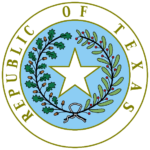 from the Republic of Texas through the Civil War and Readmission to the Union
from the Republic of Texas through the Civil War and Readmission to the Union
1839 - Hispanic, Indian and African American Texas Rangers
Tejanos (Hispanic Texans) and Indians continue to serve as Texas Rangers during the Republic of Texas era, opposing Mexican efforts to retake Texas and Indian raids.
Hendrick Arnold (1804-1849) - Earliest Documented African American Ranger

Although race is not listed on Texas Ranger enlistment rolls, one very early African American Texas Ranger has been verified. Born in Kentucky in 1804, Hendrick Arnold arrives in Mexican Texas in 1826. He is described as "a free black man from San Antonio."
His first service is during the Texas Revolution as a scout and guide for the Republic of Texas Army. He is present at the battle of San Jacinto serving in his father-in-law Erastus "Deaf" Smith's spy company.
In June of 1839, after Texas Independence, Arnold enlists in Louis Frank's Company of Mounted Volunteers, and in 1842 serves with legendary Capt. John Coffee Hays in his Bexar County Rangers.
During the Mexican War Arnold enlists in Bell's Regiment, Texas Mounted Volunteers from 1846 to 1847. This is a special regiment of U.S. Army Volunteers, including veteran former Texas Rangers, who fight as scouts, guerrillas and irregular cavalry.
Cherokee War of 1839
Disputes between white settlers, and bands of Kickapoo, Shawnee and Cherokee who have immigrated into Northeast Texas and established villages, lead to tensions and conflict between 1836 and 1839.
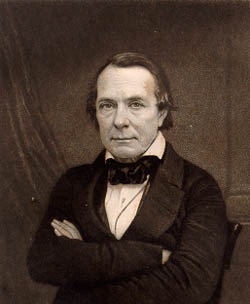 May - A letter in the hands of Mexican Agent Manuel Flores proposes an Indian uprising to retake Texas for Mexico. This tragically foreshadows the later Plan de San Diego (see 1915) and the Zimmerman Telegram (1917). In retaliation, President Mirabeau B. Lamar initiates a campaign to drive the Cherokees from Texas ignoring the service of Indians to the Republic of Texas.
May - A letter in the hands of Mexican Agent Manuel Flores proposes an Indian uprising to retake Texas for Mexico. This tragically foreshadows the later Plan de San Diego (see 1915) and the Zimmerman Telegram (1917). In retaliation, President Mirabeau B. Lamar initiates a campaign to drive the Cherokees from Texas ignoring the service of Indians to the Republic of Texas.
July - Farmers settled on Cherokee lands near Nacogdoches are killed at the hands of a faction of Cherokees. The Indians agree to leave Texas, but balk at the demand that they do so under armed escort. The Cherokee "Trail of Tears" removing them from Tennessee to Oklahoma had occurred the previous year costing an estimated 2,000 lives.
In response Gov. Lamar orders a forced removal of Indians from Texas Between July 21 and July 25 as many as 500 loosely organized Texas troops and Texas Rangers are ordered to pursue them inflicting as many as 100 casualties.
1840
March - At a peace conference with the Comanche in San Antonio, tribal leaders fail to turn over all white and Hispanic hostages as demanded. Texans do not understand, or refuse to acknowledge, that the various bands of Comanche have no single, unified leadership. The meeting erupts into the Council House Fight, and 35 Comanches and eight settlers are killed.
March to August - Retaliatory Comanche raids spread throughout Texas in response to the Council House Fight. A virtual state of war exists between the Republic of Texas and the Comanche.
August 12 - A Comanche raiding party - variously estimated at 600 to 1,000 -- reaches the towns of Linnville and Victoria on the coast, sack and burn them, then head back towards their territory in Comancheria. They are intercepted by hastily organized Texas Rangers and Texas Cavalry at Plum Creek and suffer sizable losses. This marks the end of the great Comanche raids in Texas.
1842
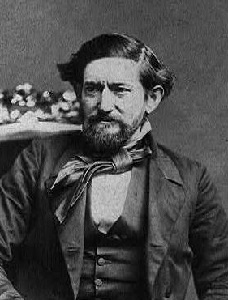 In retaliation for the Mexican defeat at San Jacinto, in March a Mexican force of 500 under Gen. Rafael Vasquez raids San Antonio, Victoria and Goliad.
In retaliation for the Mexican defeat at San Jacinto, in March a Mexican force of 500 under Gen. Rafael Vasquez raids San Antonio, Victoria and Goliad.
In September a Mexican force of 1,400 under Gen. Adrian Woll occupies San Antonio and brashly declares Texas reconquered by Mexico.
A combined force of 600 Texas Rangers, volunteers and Texas Army soldiers under Capt. Jack Hays lure the Mexican Army out of San Antonio into the Battle of Salado Creek forcing Woll's return to Mexico.
1844 - Colt Paterson
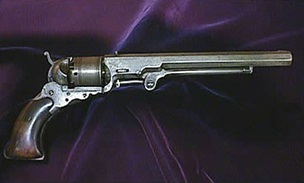 Texas Rangers under Capt. Jack Hays first use the five-shot Colt revolver (Paterson model) against the Comanche at the Battle of Walker Creek. This overcomes the Comanche advantage of firing six-to-twelve arrows in the time it took to reload a single-shot pistol or rifle,
Texas Rangers under Capt. Jack Hays first use the five-shot Colt revolver (Paterson model) against the Comanche at the Battle of Walker Creek. This overcomes the Comanche advantage of firing six-to-twelve arrows in the time it took to reload a single-shot pistol or rifle,
1845
Texas is annexed by U.S. and becomes the 28th state.
1846-48
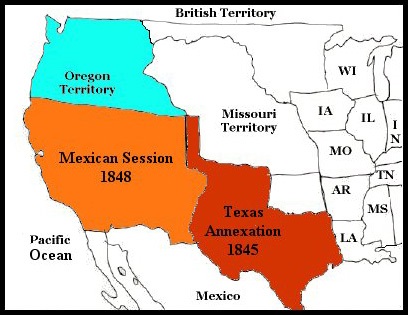 The Mexican War begins over issues such as the annexation of Texas, border raids and political philosophies such as manifest destiny.
The Mexican War begins over issues such as the annexation of Texas, border raids and political philosophies such as manifest destiny.
After initial losses, the U.S. Army realizes that they are inadequately prepared for frontier warfare. The Mexican Army is arguably one of the best equipped and trained in the world. Only a few aging US Army commanders have battlefield experience aside from the Vietnam-like Seminole Wars in the swamps of Florida.
The Army requests that Texas Rangers with experience join the U.S. Army as U.S. Volunteers. Embedded newspaper reporters remark on their their frontier dress and equipment, and irregular discipline, continuing to call them "Texas Rangers." They keep supply lines open and provide invaluable service as scouts and guerrillas. While resented by the regular army, junior commanders such as Ulysses S. Grant, Robert E. Lee and Stonewall Jackson take note of their effective horseback methods which will be used by both sides in the Civil War.
1848
The Treaty of Guadalupe Hidalgo settling the U.S.-Mexican War establishes the border of the U.S. and Mexico at the Rio Grande.
1849
Three Ranger companies (later six) are formed to patrol and protect the frontier.
1858
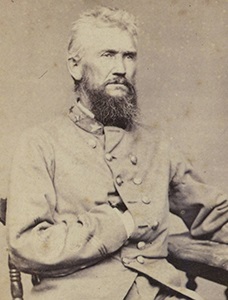 John "RIP" Ford is appointed to head the Texas Rangers. His nickname came from the many letters of condolences he wrote using the phrase "Rest In Peace" informing families of the deaths of Texas soldiers during the Mexican War. Texas Rangers kill Comanche medicine chief Iron Jacket and 78 warriors after they raid northern Texas settlements. Iron Jacket was named for an ancient Spanish coat-of-chain-mail or breastplate that he wore. He believed would make him invulnerable to the white man's bullets.
John "RIP" Ford is appointed to head the Texas Rangers. His nickname came from the many letters of condolences he wrote using the phrase "Rest In Peace" informing families of the deaths of Texas soldiers during the Mexican War. Texas Rangers kill Comanche medicine chief Iron Jacket and 78 warriors after they raid northern Texas settlements. Iron Jacket was named for an ancient Spanish coat-of-chain-mail or breastplate that he wore. He believed would make him invulnerable to the white man's bullets.
1859-60
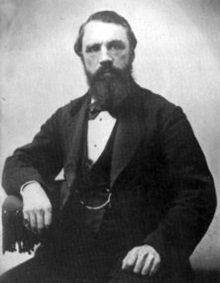 Juan Cortina and his supporters occupy Brownsville and proclaim the Republic of the Rio Grande. Cortina sought the restoration of all former Mexican land between the Nueces and Rio Grande. He initially defeats a force of Texas Rangers and local authorities, but when they are reinforced by army troops he retreats into Mexico where he wages a guerilla war for another ten years.
Juan Cortina and his supporters occupy Brownsville and proclaim the Republic of the Rio Grande. Cortina sought the restoration of all former Mexican land between the Nueces and Rio Grande. He initially defeats a force of Texas Rangers and local authorities, but when they are reinforced by army troops he retreats into Mexico where he wages a guerilla war for another ten years.
1861 - Secession
February - Texas secedes from the Union and joins the Confederacy. The 1860 population was 604,215 of which 182,566, or 30%, were slaves.
Sam Houston falls from popularity after opposing the secession of Texas.
Many Confederate military units will use the term "Ranger" (such as Terry's Texas Rangers) in their names, but are Confederate army units, not State Texas Ranger companies.
1861-65
The Confederacy orders that all able bodied men serve in the Confederate forces. The Comanche use the disorder and shortage of men caused by the war to push the line of settlement back 100 miles.
The Governor of Texas deals with the reality of the frontier by authorizing the creation of the Frontier Regiment to provide defense against Indian raids and criminals. Men in the Frontier Regiment are exempt from the Confederate draft until they are mustered en masse into Confederate service at the end of 1863 and sent to the coast.
In response, Governor Pendleton Murrah authorizes the formation of the Frontier Organization to replace it.
1866-69
Immediately following the war, ranging duties are performed by local "Minute Men" companies formed in the frontier counties. They serve at irregular intervals into the late 1870s.
There was opposition to the Texas Rangers being reconstituted by the postwar Union reconstruction administration. Among other objections, the term "Rangers" was used by CSA military units in the Civil War. For example, "Terry's Texas Rangers," was properly the 8th Texas Cavalry. Although the CSA forces were not Texas Rangers, the association was unacceptable to former Union soldiers.
1870
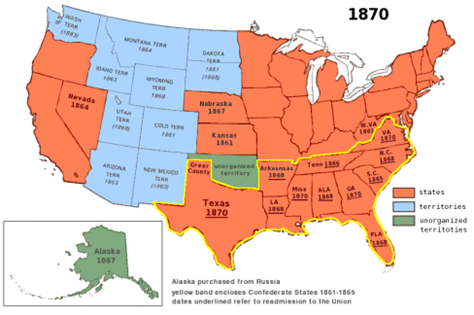 July - Rising violence and gangs move Governor Edmund J. Davis to create three organizations to fight crime: the State Police, the State Guard of Texas and the Texas Reserve Militia.
July - Rising violence and gangs move Governor Edmund J. Davis to create three organizations to fight crime: the State Police, the State Guard of Texas and the Texas Reserve Militia.
The State Police served much the same purpose as the Texas Rangers but were intensely unpopular as their ranks included former African American slaves. Additionally, their control lay with Governor Davis (they were called "the Governor's hounds") and there was rampant corruption in the command ranks, and discrimination against and interference with African American policemen in the performance of their duties.
1873
April - the State Police is disbanded and the Texas Rangers restored.
Creation of the Frontier Battalion and Special Force to the beginning of a new Century
1874
The Frontier Battalion, composed of six companies of 75 men each - later reduced to 40 men each - is created to range the frontier and uphold the laws and peace of Texas.
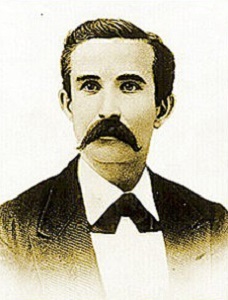 John B. Jones is appointed Major in charge of the Frontier Battalion and later becomes the Texas Adjutant General.
John B. Jones is appointed Major in charge of the Frontier Battalion and later becomes the Texas Adjutant General.
The Special Force is created to augment the Frontier Battalion and provided protection in the Nueces Strip. Leander McNelly is appointed Captain over the Force and sent to the Border. He is joined by about 36 former State Police members.
African Americans do not serve in the ranks of the Frontier Battalion or the Special Force as they did the State Police. They do join companies as teamsters and chuckwagon cooks, taking up arms in firefights and being pictured in Company group photos.
Texas Rangers intercede in the Sutton-Taylor Feud in DeWitt and Clinton counties.
1875
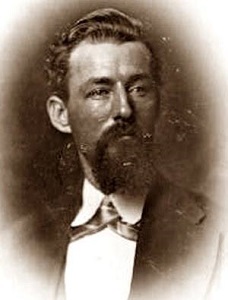 Texas Rangers intercede in the Mason County War, a disagreement between pro-Union German-Americans and former Confederates over cattle theft.
Texas Rangers intercede in the Mason County War, a disagreement between pro-Union German-Americans and former Confederates over cattle theft.
Capt. Leander McNelly and 30 Rangers illegally cross the Mexican border in pursuit of rustlers led by General Juan Cortina. After attacking the wrong ranch, McNelly and 30 men are surrounded by rustlers and Mexican troops. Defying U.S. government orders to return to Texas, McNelly demands the return of 75 head of stolen cattle and the surrender of his adversaries. The cattle are returned and McNelly leaves for Texas after provoking an international incident.
1877
Capt. Leander McNelly dies from tuberculosis. The State of Texas released him from service due to the cost of his medical bills, incapacity and no little embarrassment over his actions on the Border. The Special Force will continue its service under new leadership until merged with Company F of the Frontier Battalion in 1881.
Disputes over the control of salt deposits near El Paso leads to the El Paso Salt War. Men from the El Paso area are quickly enlisted as Texas Rangers to maintain order until experienced Rangers can arrive.
Texas Rangers in name only, the untrained, inexperienced recruits are attacked and surrounded and surrender a prisoner who is later killed. Experienced Texas Rangers arrive and are eventually able to restore order and end the "Salt War." After this incident "never surrender" becomes part of the Ranger creed.
Texas Rangers intercede in the Horrell-Higgins Feud in Lampasas and Burnet counties. Frontier Battalion Major John B. Jones ends the fighting by demanding a peace agreement.
John B. Armstrong captures outlaw John Wesley Hardin after a shoot-out in passenger train car in Pensacola, Florida.
The U.S. Army ends the Comanche threat at Palo Duro Canyon when they destroy a large portion of the Comanche horse herd.
1878
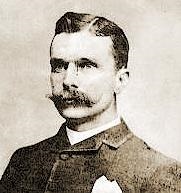 Nearly every law officer in Texas is placed on lookout for the small-time outlaw Sam Bass and his gang.
Nearly every law officer in Texas is placed on lookout for the small-time outlaw Sam Bass and his gang.
The previous year his gang attacked a Union Pacific train just outside of Ogallala, Nebraska. Expecting a small haul of cash and valuables, they were astonished to find crates of $20 "Double Eagle" gold coins fresh from the San Francisco mint intended for an eastern bank.
The 3,000 coins constituted one of the largest train robberies in history. Worth $60,000 in 1877— today the gold would be worth about $6 million at current prices.
Acting on a tip, the Texas Rangers intercept Sam Bass in Round Rock, Texas as he attempts to rob a bank and flee to Mexico. He is killed in a shootout in the streets.
1880
Capt. G.W. Arrington and Texas Rangers Company C explore the Texas Panhandle in search of Indians stealing horses from the Slaughter Ranch. During the extensive scout they locate water holes and create maps that make expanded settlement of the Panhandle possible.
1881
Apache Indians attack a stagecoach near the Diablo Mountains in West Texas. Captain George Baylor's Company A, with Pueblo Indian scouts, attack their camp. This incident effectively marks the end of the Indian Wars in Texas.
1883-88 - Fence Cutting Wars
Open range advocates and rustlers wage war on farmers and ranchers using barbed wire fence. They resort to threats, intimidation and murder to advance their cause. Rangers are called in to stop fence cutting and protect people and property.
1896 - One Riot, One Ranger
All serving Texas Rangers are summoned to El Paso to prevent the illegal Maher-Fitzsimmons heavyweight prize fight. The fight was moved to an "island" in the middle of the Rio Grande River between the U.S. and Mexico.
Ironically, this may be the event that spawned the "One Riot, One Ranger" phrase -- although virtually every Ranger in Texas was on hand.
1900
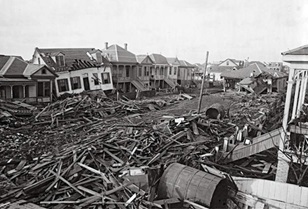 The Great Galveston Hurricane destroys the town. It was a Category 4 storm, with winds of up to 145 mph (233 km/h), which made landfall on September 8, 1900. The death toll was estimated at 6,000 to 12,000, the deadliest recorded hurricane in US history. Texas Rangers are called in to maintain peace and uphold the law in the disaster area. A Yellow Fever epidemic rages on the island claiming at least one Texas Ranger.
The Great Galveston Hurricane destroys the town. It was a Category 4 storm, with winds of up to 145 mph (233 km/h), which made landfall on September 8, 1900. The death toll was estimated at 6,000 to 12,000, the deadliest recorded hurricane in US history. Texas Rangers are called in to maintain peace and uphold the law in the disaster area. A Yellow Fever epidemic rages on the island claiming at least one Texas Ranger.
1901
The Legislature authorizes the formation of four (4) Ranger companies consisting of a total of 20 men. Their mission is to "protect the frontier against marauding or thieving parties and for the suppression of lawlessness and crime throughout the state."
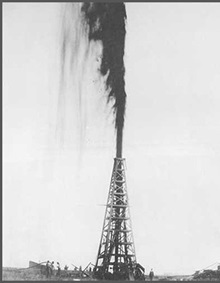 The Spindletop Oil field is discovered, beginning an oil boom in Texas that lasts into the middle of the century. Many Texas Rangers, notably M.T. "Lonewolf" Gonzaullas in the 1930s, work against crime in the boomtowns and oil fields through the 1940s. Oil from Texas fuels the U.S. armed forces during World War II.
The Spindletop Oil field is discovered, beginning an oil boom in Texas that lasts into the middle of the century. Many Texas Rangers, notably M.T. "Lonewolf" Gonzaullas in the 1930s, work against crime in the boomtowns and oil fields through the 1940s. Oil from Texas fuels the U.S. armed forces during World War II.
1910
The Mexican Revolution causes increased violence on both sides of the border.
Politicians on the losing side of Mexican power struggles, such as Francisco "Pancho" Villa, flee north to the Texas border. They and other gangs establish control over land by indiscriminately terrorizing Mexican, Tejano (Texas Hispanic) and White populations.
Bandit and gang raids eventually kill hundreds of Mexican and US citizens for supplies, food, cattle and valuables. Texas ranchers, farmers and citizens form vigilantes. Local and State governments groups further increase the violence and tensions.
Some Texans see any Tejano or Mexican Hispanic as "bandits" and retaliate. Some Mexicans and Tejanos see any armed white man on a horse as a "Ranger." Racial tensions and violence add fuel to decades of anger over cattle thefts and land disputes.
1915-16 - The Plan de San Diego
Panic further spreads in 1915 when authorities in McAllen, Texas, arrest Basilio Ramos, Jr. Ramos who is carrying a copy of the Plan de San Diego, a revolutionary manifesto supposedly written and signed at the South Texas town of San Diego.
It calls for the formation of a "Liberating Army of Races and Peoples," of Mexican Americans, African Americans, and Japanese, to "free" the states of Texas, New Mexico, Arizona, California, and Colorado from United States. Versions of the plan call for the murder of all white citizens over 16 years of age. The goal is an independent republic, which might later seek annexation to Mexico.
Francisco "Pancho" Villa's raid on Columbus, New Mexico in March of 1916, is widely taken as proof of support for the Plan de San Diego. Villa's men attack a regular US Army Cavalry unit, kill an estimated 18 persons, and burn the town of Columbus.
Raids from both sides of the border quickly escalate and the United States responds by sending a large military force under Gen. John J. Pershing in pursuit of Villa.
Texas responds by mass-inducting untrained and ill-prepared men into new Ranger companies. The Ranger Force is very small and incapable of maintaining law and order.
The Ranger force grew to its largest level, but the lack of training and controls were evident. Some of the new companies uphold the law while others function as vigilantes incensed by raids from Mexico. Hispanic, as well as Anglo, Texans served in these units.
These Rangers are given orders "... to keep them (Mexican raiders) off of Texas territory if possible, and if they invade the State, let them understand they do so at the risk of their lives."
Mexican raids into Texas in 1915-16 cause an estimated 21 American deaths. An estimated 300 Mexicans or Tejanos were likely killed in South Texas by the actions of vigilantes, Texas Rangers, the US Army and citizens. Some sources claim death tolls as high as 3,000 but evidence is lacking.
The vigilante nature and poor command structure of the Texas Rangers led to civilian deaths. One retaliatory raid into Mexico may have killed as many as 20 Mexican citizens. An entire Ranger company is dismissed in the aftermath.
The 35th legislature creates a "Loyalty Ranger Force," a highly political group bearing commissions but performing little field service. "Loyalty Rangers" are assigned to brief the Adjutant General on Mexican revolutionary activities outside of San Antonio and in the border counties in Mexico and Texas.
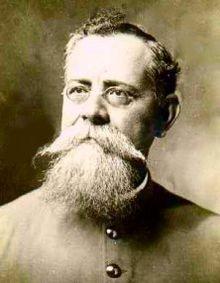 In response to the presence of US troops on Mexican soil, President Venustiano Carranza demands the withdrawal of US forces, which is summarily rejected by the US government. Mexican raiding intensifies and an attack against Laredo is considered with a combined force of "San Diego raiders" and regular Mexican Army soldiers. A state of war is narrowly averted when US and Mexican officials agree to a peaceful reconciliation.
In response to the presence of US troops on Mexican soil, President Venustiano Carranza demands the withdrawal of US forces, which is summarily rejected by the US government. Mexican raiding intensifies and an attack against Laredo is considered with a combined force of "San Diego raiders" and regular Mexican Army soldiers. A state of war is narrowly averted when US and Mexican officials agree to a peaceful reconciliation.
1917 - The Zimmerman Telegram
The fragile peace on the Border is again threatened in 1917. Fearing US entry into World War I, the Imperial German Foreign Office sent a coded telegram to Mexico proposing an alliance. It was intercepted and deciphered by British Military Intelligence.
"...we make Mexico a proposal of alliance on the following basis: make war together, make peace together, generous financial support and an understanding on our part that Mexico is to reconquer the lost territory in Texas, New Mexico, and Arizona. The settlement in detail is left to you. You will inform the President of the above most secretly as soon as the outbreak of war with the United States of America is certain...."
Mexican President Venustiano Carranza assigns a military commission to consider a Mexican invasion of the Southwest as proposed by Germany. But when news of the telegram explodes onto the national news, fanned by the Hearst newspaper chain, Mexico declines the offer. However, this further inflamed national and racial hatreds along the border.
On Christmas Day, 1917 suspected followers of Francisco "Pancho" Villa attack the ranch of Lucas Brite in Presidio County. They kill two Mexican passengers at the stage station, hang the driver and lay siege to the remainder of persons at the ranch.
1918
In January of 1918 Texas Rangers from Company "B", soldiers from the 8th US Cavalry and ranchers search the settlement of Porvenir for evidence of property stolen from the Brite Ranch.
Accounts are conflicting, but it is certain that fifteen residents are executed without due process on the premise of being "bandits." The act is condemned on both side of the Border. The Capt. of Co. "B" is fired and the Rangers are dismissed.
Justifiably stronger action is not taken in the inflammatory climate of the Plan de San Diego, the Zimmerman Telegram and Villa raids. In 1919, hearings and investigations lead to reforms of the Texas Rangers. A memorial to the massacre and those killed is erected in 2018 outside Marfa.
1919
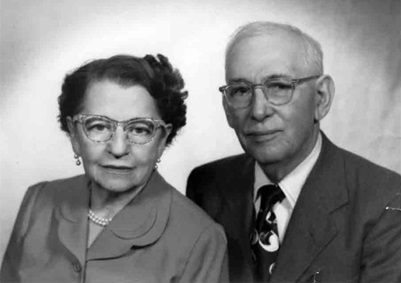 In January of 1919 Representative José T. Canales of Brownsville demands a legislative investigation of the conduct of the various Ranger forces during the period 1915-1917 and the reorganization of the force. The Texas Legislature investigates nineteen charges made against the Texas Ranger forces in the aftermath of the Plan of San Diego and the War.
In January of 1919 Representative José T. Canales of Brownsville demands a legislative investigation of the conduct of the various Ranger forces during the period 1915-1917 and the reorganization of the force. The Texas Legislature investigates nineteen charges made against the Texas Ranger forces in the aftermath of the Plan of San Diego and the War.
The investigation results in the reduction of the Ranger force to four companies of 17 men each. A tightening of qualifications leads to greater professionalization in the Texas Ranger service.
1920-33 - Prohibition
National Prohibition becomes law. Rangers work closely with Federal agents to confiscate illegal alcohol smuggled from Mexico and destroy stills. They shut down liquor distribution networks, illegal gambling parlors and speakeasies.
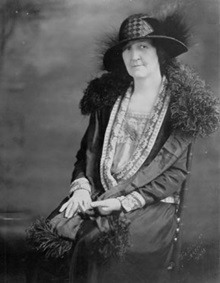 1932
1932
Miriam "Ma" Ferguson is elected governor of Texas for the second time. In protest over political patronage and corruption, 40 Rangers quit the force and the remainder are dismissed. Political appointees replace them.
1934
Following an investigation of corruption in the Ferguson administration, a panel recommends the formation of the Texas Department of Public Safety headed by an independent Public Safety Commission. Newly elected Governor Allred revokes the commissions of all Texas Rangers appointed by the Ferguson administration.
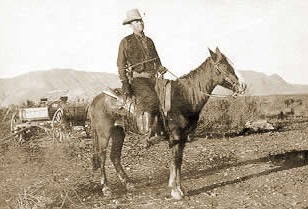 Former Texas Rangers Frank Hamer and Manny Gault (who left service when the Ferguson administration gained power) are commissioned as special investigators to end the crime spree of notorious outlaws Clyde Barrow and Bonnie Parker.
Former Texas Rangers Frank Hamer and Manny Gault (who left service when the Ferguson administration gained power) are commissioned as special investigators to end the crime spree of notorious outlaws Clyde Barrow and Bonnie Parker.
The criminal duo broke into the Texas State Prison in Huntsville to rescue a gang member, and also shot their way out of two previous attempted arrests. Hamer and Gault decide to take no chances. They set up an ambush on a rural Louisiana road and pour a hail of bullets into the car. The shooting ends the lives of Bonnie & Clyde, but gives birth to a legend.
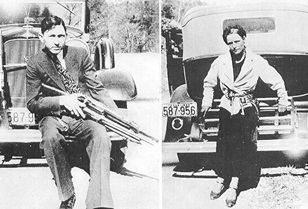 The 1967 movie Bonnie & Clyde starring Faye Dunaway and Warren Beatty, will resurrect the groundless legend of Bonnie & Clyde. Painting them as part "Romeo & Juliet" and part "Robin Hood," the film will soft-pedal their killing of at least 13 police officers and citizens. In one incredibly inaccurate scene, the movie depicts the pair capturing Frank Hamer -- an event that never occurred. Hamer's widow and son sued the producers and won an out-of-court settlement for defamation of character.
The 1967 movie Bonnie & Clyde starring Faye Dunaway and Warren Beatty, will resurrect the groundless legend of Bonnie & Clyde. Painting them as part "Romeo & Juliet" and part "Robin Hood," the film will soft-pedal their killing of at least 13 police officers and citizens. In one incredibly inaccurate scene, the movie depicts the pair capturing Frank Hamer -- an event that never occurred. Hamer's widow and son sued the producers and won an out-of-court settlement for defamation of character.
The Texas Rangers serve under the newly formed Department of Public Safety as lead investigators for the State of Texas.
1935
August - The Texas Department of Public Safety is founded in an effort to remove State law enforcement from political influence and further professionalize it.
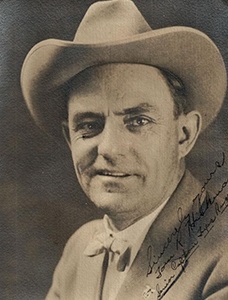 The first divisions were the Texas Highway Patrol (motorcycle), the Texas Rangers and the Bureau of Intelligence/Crime Laboratory. The three divisions are headed by current and former Texas Rangers.
The first divisions were the Texas Highway Patrol (motorcycle), the Texas Rangers and the Bureau of Intelligence/Crime Laboratory. The three divisions are headed by current and former Texas Rangers.
The first Director of Texas DPS is Louis G. Phares, previously Chief of the Texas Highway Motor Patrol and a Special Texas Ranger from 1929-31. Capt. Tom Hickman is commissioned to lead the Texas Rangers as Senior Texas Ranger Captain. Former Texas Ranger Capt. Manuel T. Gonzaullas was named Superintendent of Intelligence.
1936
Texas celebrates its Centennial at Fair Park in Dallas.
A centerpiece of the Fair is the log Company "B" Texas Rangers headquarters building. Numerous celebrities including Shirley Temple visit.
The world premier of producer/ director King Vidor's movie The Texas Rangers takes place at the Centennial Fair.
The Texas Rangers: A Century of Frontier Defense written by famed historian Walter Prescott Webb's is published. It will remain the sourcebook for Texas Ranger history for more than 50 years.
Hastily written for the Centennial, later historians will criticize errors and gaps in The Texas Rangers. It is later replaced by more accurate and balanced surveys (such as Robert Utley's two-part Lone Star Justice and Lone Star Lawmen) and Charles Harris and Louis Sadler's study The Texas Rangers and the Mexican Revolution: the Bloodiest Decade 1910-1920.
1939
September - Despite U.S. neutrality, Capt. Frank Hamer and 49 retired Texas Rangers offer their services to the King George VI of England to defend their shores against Nazi invasion. The U.S. State Department is not happy, but the British likely are amused and appreciative. His Majesty thanks Capt. Hamer and the retired Rangers for their offer.
During the war, rumors that "Rangers" will infiltrate Nazi Germany causes concern in the Reich. The rumors were based on tales of U.S. Army Ranger commandos, but so famous are the Texas Rangers in film and novels that the Gestapo and Ministry of Propaganda assumed they might face wild Texas Rangers.
1941-45
During World War II, US Army Criminal Intelligence Division officers train with the Texas Rangers at the DPS headquarters in Austin in investigative techniques.
1946
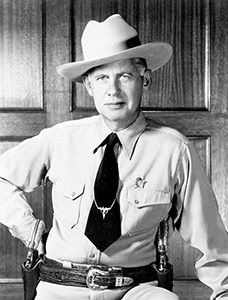 The "Texarkana Phantom Killer" murders five and wounds three young people in Texarkana, Texas in lovers lane crimes..
The "Texarkana Phantom Killer" murders five and wounds three young people in Texarkana, Texas in lovers lane crimes..
After the third murder, Texas Ranger Captain Manuel T. "Lonewolf" Gonzaullas is called in to head the investigation. Although he followed hundreds of leads, no arrest is made. The case is still open. The prime suspect dies in a rest home many years later.
1949
The Texas Department of Public Safety builds a new campus in Austin including administrative offices and training facilities. The Texas Rangers acquire their first airplane.
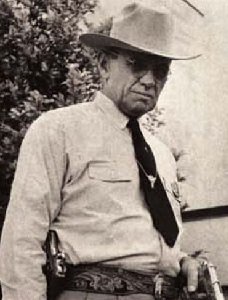 1955
1955
Texas Ranger Capt. Bob Crowder peacefully resolves a hostage situation at the Rusk Hospital for the Criminally Insane.
1956
In August of 1956 Governor Alan Shivers sends Texas Rangers to Mansfield, Texas during federally ordered school desegregation following Brown v. Board of Education in 1954.
Governor Shivers, a segregationist, specifically orders the Rangers not to assist the African-American students in registering. Their registration is prevented by local sentiment heavily against desegregation with mobs, assaults of desegregation supporters and threats of violence. Mansfield schools do not integrate until 1964.
in September, Gov. Shivers again sends Texas Rangers to Texarkana, Texas, when two African-American students attempt to register at Texarkana Junior College. The Rangers are instructed to maintain order and prevent violence, but given no authority to escort the students to register.
In 2020 a statue of a Texas Ranger at Love Field in Dallas is removed after it becomes known that it was modeled on a Texas Ranger sent to Mansfield by Governor Shivers.
1966-67
Migrant Hispanic farmworkers in the Rio Grande Valley stage nonviolent protests and seek to organize over wages and living conditions Growers and officials in Starr County ask the State to intervene on their behalf and suppress the protests.
Texas Rangers under Capt. A.Y. Allee are unwisely sent to enforce local warrants. Heavy-handed responses and enforcement of outdated Texas statutes result in confrontations and Civil Rights violations. Lawsuits are filed ultimately ending up in the U.S. Supreme Court.
Policy and Texas laws are changed so that Texas Rangers will never again be sent to police peaceful labor disputes.
About this and other labor disputes, Ranger Glenn Elliott stated, "Our job should have been working murders, bank robberies and other major criminal cases, not trying to keep two sides [in a labor dispute] apart..."
1968-69
In stark contrast to the nonviolent farmworker protests, the longest and most violent strike in Texas history erupts at the Lone Star Steel Plant east of Dallas in Morris County. Strikers and management are involved in gunplay, drive-by shootings, bombings and over 200 assaults.
Morris County had only three law enforcement officials; the State sent in as many as 26 Texas Rangers and 46 Highway Patrol to keep the peace. Capt. Bob Crowder adopted a low-key approach informing all parties that he was there only to prevent violence and enforce the laws.
After seven months the strike subsided.
1969-74
Following the farmworker strikes of 1966-67, there were calls to expand modern Hispanic representation in the Texas Rangers. Hispanics served as Texas Rangers in all ranks from the 1820s into the 1930s. However, by the 1960s racial diversity had declined.
The first Hispanic Rangers of the new era are Arturo Rodriguez, Rudolfo Rodriguez and Ray Martínez. They are assigned to Company "D" in South Texas investigating major crimes in and around Laredo, Crystal City, San Antonio and New Braunfels.
1974
Fred Carrasco and two other prisoners take over the library and educational facility at the Walls Unit of the Texas State prison in Huntsville. Ranger Captains Pete Rogers and G.W. Burks lead an assault to free the hostages.
1968
The Col. Homer Garrison Texas Ranger Museum is opened in Waco as the official Texas Department of Public Safety museum for the Texas Rangers. Entertainer Danny Thomas attends the opening.
1976
In commemoration of the 150th anniversary of the Rangers in 1973, the State Legislature creates the Texas Ranger Commemorative Commission with goal of raising funds to build a State Memorial, the Texas Ranger Hall of Fame, at the Texas Ranger museum in Waco.
The Memorial is dedicated in 1976 and the historical center is renamed The Texas Ranger Hall of Fame and Museum.
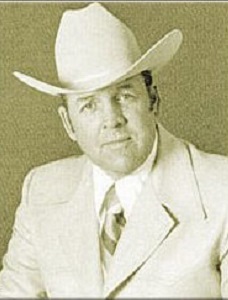 1978
1978
Texas Ranger Bobby Doherty is killed during a drug raid in Denton, Texas. Doherty was the first Texas Ranger in 47 years to die in the line of duty.
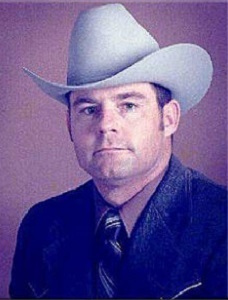 1987
1987
Texas Ranger Sgt. Stan Guffey is killed while saving the life of a child during a kidnapping. He is posthumously awarded the Texas Department of Public Safety Commissioners Medal of Valor and later inducted into the Texas Ranger Hall of Fame.
1988
Le Roy Young, a Navy veteran from Del Rio, is promoted from the Highway Patrol as the first known African-American Texas Ranger in the 20th century. Young identifies himself as a "Black Seminole" being of Seminole Indian and African-American heritage. In 1994 Christine Nix, also a military veteran and former police officer, is promoted as the first female African-American Texas Ranger.
1993
Gender diversity in State government receives attention in the administration of Governor Ann Richards. The first female Texas Rangers of the modern era are promoted from Texas DPS. In the 1930s, special Ranger commissions were held by women appointed to handle sensitive State documents. A regular Texas Ranger Commission was held by a woman serving as security at the Governor's mansion in Austin.
The Texas Rangers begin an investigation into the deaths of four ATF agents following the attempted execution of a search warrant at the Branch Davidian Compound at Elk, Texas, 15 miles from Waco. Follow-up investigations by the Texas Rangers and trials related to the tragedy will extend into 2000.
1997
Texas Rangers commanded by Capt. Barry Caver conduct hostage negotiations with the Republic of Texas, a militant political organization which claims Texas is still an independent nation. Texas Rangers are able to secure the release of all hostages and negotiate the surrender of most of those involved.
The Texas Ranger Hall of Fame and Museum is named the Official State Repository for Texas Ranger memorabilia by the state legislature.
1998
The 175th anniversary of the Texas Ranger Service is commemorated by the Texas Ranger Hall of Fame and Museum with a time capsule to be opened in 2098. The Texas Ranger Hall of Fame and Museum celebrates its 30th anniversary.
1999
A nationwide manhunt for accused serial murderer Angel Maturino Resendez is launched by the FBI. An investigation by Ranger Sergeants Drew Carter and Brian Taylor of Company A result in Resendez' surrender in El Paso.
Texas Ranger Sgt. Matt Cawthon of Company F, U.S. Postal Inspector R.C. "Bob" Adams and Bellmead, Texas Detective Thomas Noble end a widespread child pornography ring They receive citations from Congress, the Department of Justice, the Fraternal Order of Police and the National Center for Missing and Exploited Children.
2000-01
The third century in which the Texas Rangers will serve begins with the Rangers at an authorized strength of 107 and Senior Captain Bruce Casteel in command.
The Texas legislature directed the Texas Rangers to establish the Unsolved Crime Investigation Program (UCIP). The program’s primary objective is to provide Texas law enforcement agencies with assistance in investigating unsolved murders or what appear to be serial or linked criminal transactions. The investigation of serial sex offenders is included in this program.
 2002
2002
Colonel Paul Lockhart, pilot of Space Shuttle mission STS-111, takes Texas Ranger badges into orbit in honor of the upcoming 180th anniversary of the Texas Rangers (in 2003).
2004
Earl R. Pearson becomes the first African-American Chief of the Texas Rangers. He serves as chief from May 2004 to August 2005.
2008
Chief Antonio "Tony" Leal becomes the first modern Hispanic Texas Ranger Chief. He serves as chief from December 2008 to March 2011.
New expansion of Texas Ranger roles and responsibilities begins what many Rangers and historians believe is a new era for the Texas Rangers.
2010
August 6, 2010 - The Texas Department of Public Safety (DPS) celebrates its 75th anniversary at DPS Headquarters in Austin.
Texas Ranger Cody Mitchell and Texas DPS Lt. Derek Prestidge co-found the Interdiction for the Protection of Children (IPC) Program is founded to help troopers identify and rescue endangered children.
In a trial program, there were 47 criminal investigations involving possession of child pornography, the sexual assault of children, human trafficking, enticing children and abductions. Officers were able to identify and intervene in at least 139 cases of missing or sexually exploited children.
The program is subsequently expanded and taught to departments internationally from Australia to Great Britain. It is moved under the Training Division of Texas DPS.
2011
August - A raid of the Yearning for Zion Ranch (YFZ Ranch), results from an investigation into the polygamy practices of the Fundamentalist Church of Jesus Christ of Latter-Day Saints (FLDS Church). Warren Steed Jeffs, the President of the FLDS Church, is convicted of two felony counts of child sexual assault. He is sentenced to life plus 20 years.
October - The Special Operations Group (SOG) is created by Texas DPS Director McCraw to address the growing escalation in illegal narcotics trafficking, human smuggling and violence in the Texas Border region.
The Texas Rangers begin applying state-of-the-art land surveying technology to criminal investigations. They utilized a Leica Geosystems ScanStation C10 Laser Scanner which creates a permanent 360° digital photographic image and maps millions of laser data points to millimeter accuracy. This enables a single Ranger to make a precision 3D map of a crime scene in minutes.
2014
Texas Ranger Wende Wakeman is promoted to the rank of lieutenant (and Captain in 2020), making her the highest-ranking female in Texas Ranger history. In 2020, Texas Ranger Lieutenant Melba Saenz also is promoted to Captain. They are the first two female Ranger captains in DPS history.
September - The Texas Ranger Hall of Fame and Museum celebrates its 50th Anniversary. Over 4.5 million people have come through the museum since its opening.
2019
SAKI is a program funded by the U.S. Department of Justice (DOJ) Bureau of Justice Assistance (BJA) to assist with furthering collection of offender DNA and identifying and prosecuting violent serial sex offenders. In 2019, the Texas Rangers received two grants from the DOJ BJA. These grants received by the Texas Rangers are for the collection and entry of lawfully owed DNA into the Combined DNA Index System (CODIS), and the investigation and prosecution of cold case sexually related homicides and sexual assault cases, including violent serial sex offenders.
2021
In November 2021, Colonel Steven McCraw created a DPS Fellowship Program with the Office of the Governor. Major James Thomas became the first DPS Fellow to the Office of the Governor until his return to Co. "F" as its Major in late 2022.
In 2021 the Texas Public Safety Commission sanctioned an organization, Texas Ranger 2023, to spearhead commemorations of the anniversary throughout the State. Celebratory activities will be handled by citizens committee of the Texas Ranger Bicentennial 2023 organization. TEXAS RANGER BICENTENNIAL™ 2023 Three organizations central to the Texas Rangers will be participating:
- The Texas Department of Public Safety Foundation
- The Texas Ranger Hall of Fame and Museum
- The Texas Ranger Association Foundation
2023
Bicentennial of the Texas Rangers - The 200th Anniversary of the Texas Rangers will be an event of national significance commemorating the oldest serving Statewide law enforcement agency in the nation.
March - Congressman Pete Sessions and Senator Ted Cruz sponsored resolutions recognizing and honoring the Texas Rangers for their 200 years of service in the US Congress.
June - Four new inductees are formally added to the Hall of Fame: Johnnie Aycock, Homer Garrison Jr., John Martin and James Frank "Pete" Rogers.
Johnnie Aycock
Homer Garrison, Jr.
John Martin
James Frank "Pete" Rogers